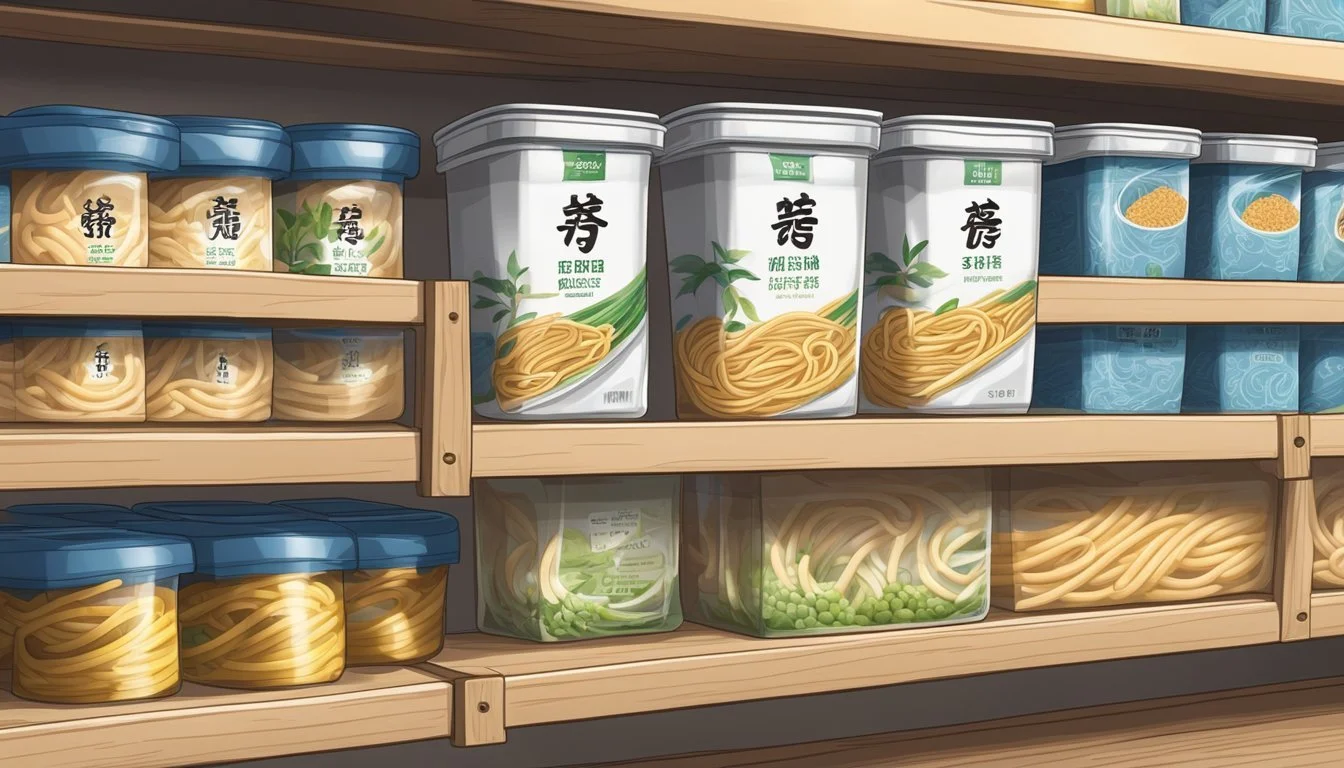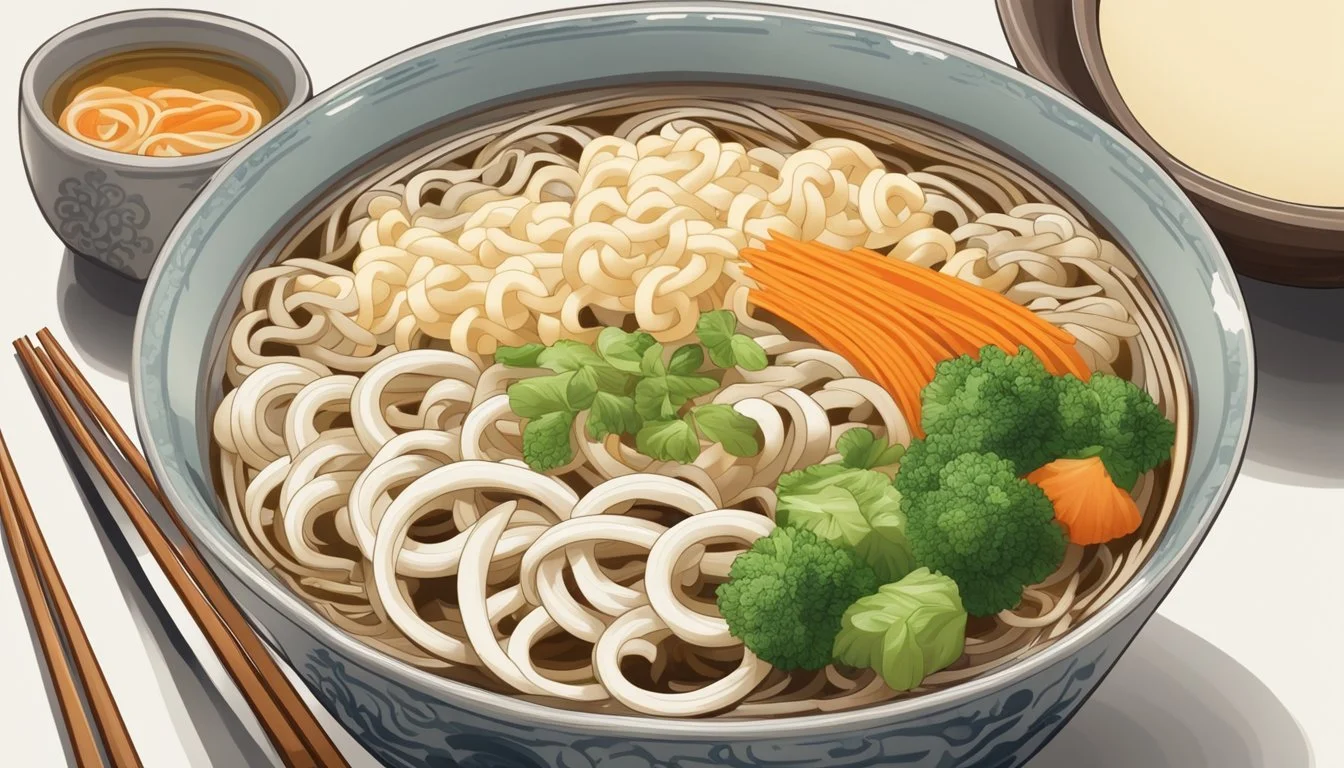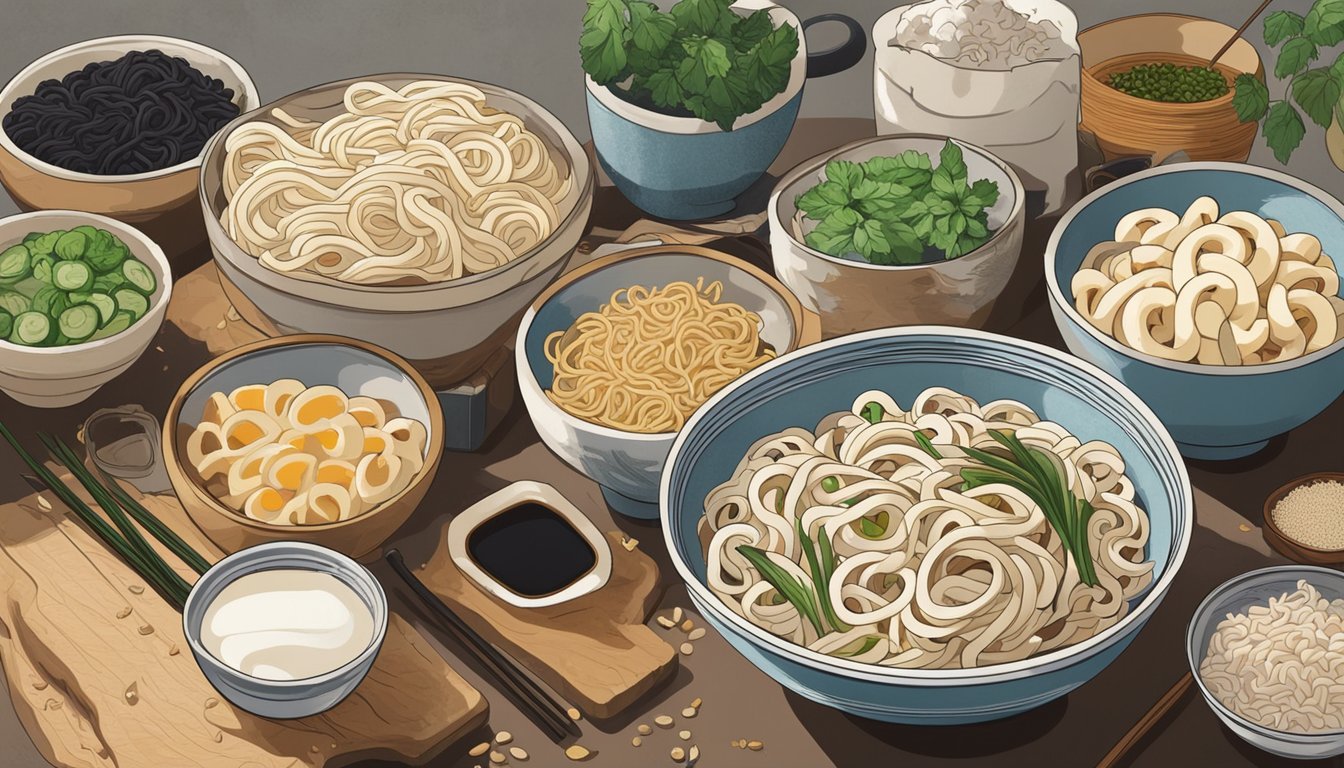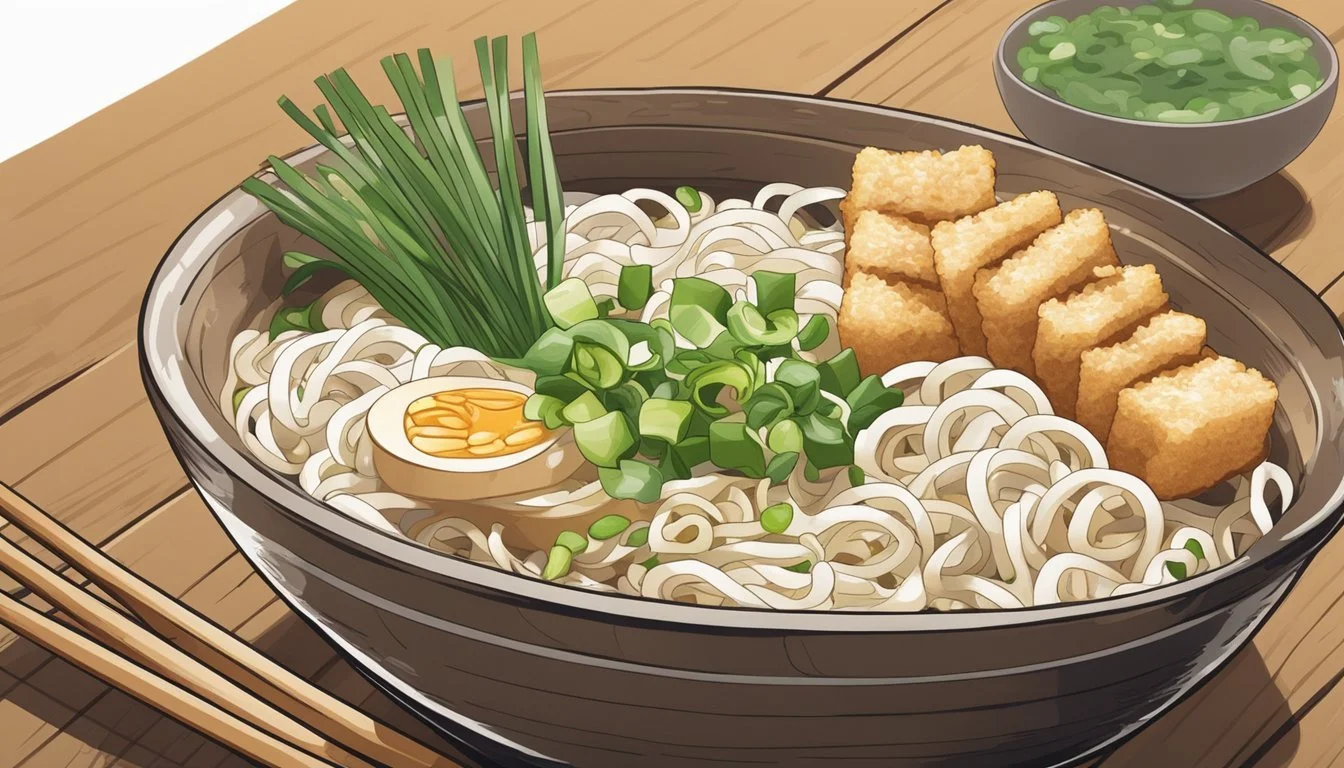How Long Do Udon Noodles Last?
Shelf Life and Storage Tips
Udon noodles, originating from Japan, are a beloved staple in Japanese cuisine known for their thick, chewy texture. These noodles are versatile and can be enjoyed in various dishes, such as soups, stir-fries, and salads. When it comes to shelf life, the longevity of udon noodles depends on their state—dry, fresh, or frozen—as well as storage conditions.
Dry udon noodles, which are brittle and shelf-stable, can last for several months when stored in a cool, dry place. Typically, unopened dry udon noodles have a shelf life that can extend up to a year. On the other hand, fresh udon noodles, found in the refrigerated section, have a shorter shelf life due to their higher moisture content. These noodles can last about two to three weeks in the refrigerator and should be consumed quickly once opened.
For those who purchase udon noodles in bulk or cannot consume them within the recommended time frame, freezing provides a convenient solution. Fresh udon noodles can be frozen for up to three months without significant loss of quality. Frozen udon allows for prolonged storage while maintaining the distinctive texture that is characteristic of this Japanese noodle. Proper storage is crucial for extending the life of udon noodles while ensuring they remain safe and delicious to eat.
Understanding Udon Noodles
Udon noodles hold a distinctive place in Japanese cuisine, known for their thick, chewy texture and versatility in various dishes.
Types of Udon Noodles
Udon can be categorized mainly into two types—fresh udon and dried udon. Fresh udon noodles are plump, round, and offer a soft yet chewy texture reflective of their freshly prepared wheat flour dough. They often come sealed and are preferred for their lively and supple texture. On the other hand, dried udon tends to be flatter and more akin in shape to fettuccine; these noodles are perfect for longer storage and can be rehydrated to attain a firm, hearty bite that holds up well in soups and stir-fries.
Fresh Udon:
Shape: Round, plump
Texture: Soft, chewy
Dried Udon:
Shape: Flat, similar to fettuccine
Texture: Firmer than fresh, requires rehydration
Ingredient Composition
The backbone of udon noodles is wheat flour, which imparts the characteristic chewy texture and understated taste that makes udon noodles an ideal backdrop for a variety of flavors, from subtle broths to robust sauces. Traditional udon dough is comprised solely of wheat flour, water, and salt, resulting in thick strands that are both satisfying to bite into and carry flavors well. The simplicity of the ingredients underscores the importance of texture and shape—whether the noodles are flat and thin for drying or round and thick for immediate consumption. This simplicity also allows udon to be a versatile element in countless Japanese dishes.
Storage of Udon Noodles
Proper storage of udon noodles is critical for maintaining their quality and extending shelf life. Different storage methods can significantly affect the freshness and edibility of udon noodles.
Optimal Storage Conditions
For unopened packages of udon noodles, an individual should store them in a cool, dry place such as a pantry. If the noodles are vacuum-sealed, this will typically preserve the noodles for up to 10 months at room temperature. Once opened, or if the noodles are fresh, storing them in an airtight ziploc bag or plastic bag in the fridge is recommended to maintain freshness.
Vacuum-Sealed Packs: Up to 10 months at room temperature.
Opened or Fresh Noodles: Store in the refrigerator; consume within 3-5 days.
Effects of Temperature on Shelf Life
The shelf life of udon noodles varies with temperature. If one stores noodles at room temperature, they have a shorter shelf life compared to being stored in the fridge. In the refrigerator, udon noodles can last for several days, with a maximum recommended span of 3-5 days to ensure quality. For a longer storage solution, freezing the udon noodles can extend their shelf life significantly. When stored in the freezer, udon noodles can last for up to three months.
Refrigerator: 3-5 days for optimal freshness.
Freezer: Up to 3 months; store in an airtight container or heavy-duty freezer bags to prevent freezer burn.
Shelf Life by Type
Udon noodles' shelf life can substantially vary depending on whether they are fresh, frozen, or dried. These types of noodles each have different storage methods and durations for optimal freshness.
Fresh Udon Noodles
Fresh udon noodles typically come refrigerated and should be consumed within 7 days of purchase. If the package has been opened, it's important to keep them sealed tightly to maintain freshness.
Frozen Udon Noodles
Frozen udon noodles have a longer shelf life and can be stored for several months. To ensure quality, one should avoid thawing and refreezing the noodles, as this can negatively affect their texture and taste.
Dried Udon Noodles
Packaged dry udon noodles, not requiring refrigeration, can last up to 11 months when kept in a cool, dry place. If the package is unopened, they remain safe to eat beyond that period, though the quality might diminish.
Preparation Method Impact
The shelf life of udon noodles is often affected by how they are prepared. Different methods can influence their texture, flavor, and longevity once cooked.
Cooking Udon Noodles
When preparing udon noodles by boiling, one must ensure that they are cooked in a pot of boiling water. Boiling is best done for a period of 8 to 10 minutes, depending upon the thickness of the noodles. After boiling, draining them and rinsing under cold running water prevents sticking and maintains texture.
Frying Udon Noodles
For stir-frying, the noodles first need to be boiled as described above. Then they are typically added to a pan with oil, along with other ingredients such as vegetables or proteins. The boiled noodles have now become stir-fried udon, which usually have a heartier taste and a more substantial texture due to the caramelization and additional flavors from the stir-fry process.
Incorporating Udon Noodles in Dishes
Udon noodles are versatile and can significantly enhance a variety of dishes, especially Japanese noodle soups and stir-fries. They can also be served cold in salads, offering a diverse range of uses in culinary applications.
Udon Noodle Soups
Udon noodle soups are a staple of Japanese cuisine, combining the chewy texture of udon with flavorful broths. To prepare Udon Noodle Soup, one should start with a base of rich broth, typically made from dashi, soy sauce, and mirin. The noodles are then cooked according to package instructions, usually for about 2 to 3 minutes, before being added to the soup during the final moments of cooking. Toppings can include thinly sliced scallions, tempura, fish cakes, or soft-boiled eggs.
Udon in Stir-fries and Salads
For Stir-fries, udon noodles offer a satisfying texture that holds up well against high heat and robust flavors. They should be briefly cooked, usually for 2 to 3 minutes, then rinsed and added to the stir-fry, ensuring they absorb the sauce without becoming too soft. Incorporating vegetables, protein, and a sauce that can include elements like soy sauce, ginger, and garlic will result in a well-rounded dish.
When used in Salads, udon noodles are first cooked and then chilled. This pasta is then combined with a mix of fresh, crunchy vegetables and a light dressing to complement the noodles' subtle taste. It’s common to use a soy sauce or sesame-based dressing and to top the salad with sesame seeds (how long do sesame seeds last?), herbs, or crushed nuts for added texture. Udon noodle salads are particularly refreshing in warmer weather, making them an ideal cold dish option.
Recognizing and Handling Spoilage
When determining the freshness of Udon noodles, one must be vigilant about changes in texture, smell, and taste, as these are indicative of spoilage.
Signs of Spoiled Udon Noodles
Texture: Fresh Udon noodles should be pliable and firm. If they have become slimy or excessively sticky, this is a sign that they may not be suitable for consumption.
Smell: A fresh, neutral smell is characteristic of Udon noodles that are good to consume. Should there be an off or sour odor emanating from the noodles, they may have spoiled.
Taste: It is not recommended to taste noodles that show signs of spoilage. However, a sour or unpleasant taste can indicate that the noodles are no longer safe to eat.
Food Safety Guidelines
Storage: Udon noodles should be stored properly in the refrigerator at or below 40°F (5°C) and are best consumed within 7 days of opening. If they have been left out at room temperature for more than 2 hours, they should be discarded.
Observation: Before preparing or consuming Udon noodles that are near or past their expiration date, one should carefully inspect for signs of spoilage such as changes in texture and smell.
Disposal: Noodles that exhibit any signs of spoilage should be thrown away immediately to prevent the risk of foodborne illness. It is always safer to err on the side of caution when it comes to consuming potentially spoiled food items.
Alternative Udon Uses and Leftovers
Udon noodles, with their chewy texture, serve as a versatile ingredient in various dishes. They can be transformed into entirely new meals with just a few additional ingredients like vegetables, proteins, or sauces.
Repurposing Cooked Udon
Cooked udon noodles that are leftover can be given new life in a stir-fry or soup. They pair well with an array of vegetables such as bell peppers, carrots, and mushrooms. In a stir-fry, cooked udon can be quickly reheated and combined with:
A protein such as chicken, beef, or tofu.
A simple sauce made from soy sauce, mirin, and a touch of sugar.
Additionally, one can toss these noodles into a hot curry to soak up the flavors or into a broth-based soup, bolstering the dish's heartiness.
Creative Leftover Ideas
Leftovers shouldn't have to be a repeat of the previous meal. Udon noodles, being highly adaptable, can evolve into a satisfying new dish. Here are a few curated ideas:
Transform into a salad: Toss cold udon with a sesame oil (how long does sesame oil last?) and rice vinegar dressing, sliced green onions, and shredded chicken or tofu.
Make noodle pancakes: Combine chopped udon with egg as a binder, add some finely chopped vegetables, and pan-fry until crisp.
For those with an abundance of udon, consider freezing some. Frozen udon maintains quality and can provide a quick meal base at a later time. To freeze, simply portion the noodles, ensuring they are thoroughly dried, and store them in an airtight container.
Comparison with Other Noodles
In this section, comparisons will be drawn between Udon noodles and other types of noodles such as Soba and wheat-based pasta in terms of shelf life and storage recommendations.
Udon vs Soba Noodles
Udon noodles, originating from Japan, are thick, white noodles made from wheat flour and known for their chewy texture. They typically have a shelf life of up to 12 months when refrigerated or up to 10 months at room temperature. Soba noodles (how long do soba noodles last?), on the other hand, are made from buckwheat flour (how long does buckwheat flour last?) and offer a nuttier flavor and a firmer texture. The shelf life of soba noodles mirrors that of udon when they are dried. However, because buckwheat can go rancid, it's crucial to store soba in a cool, dark place, and they often have a shorter shelf life compared to udon if the soba contains a higher percentage of buckwheat flour.
Udon vs Wheat-Based Pasta
Udon noodles differ from traditional Italian wheat-based pasta such as spaghetti or fettuccine in terms of size, shape, and ingredients. While Italian pasta can last for a year or even longer when dry and stored properly, udon has a slightly less shelf life. The storage of udon is simpler as it doesn't require refrigeration unless it's vacuum-packed. Spaghetti and fettuccine are better off in a dry, cool pantry. All three should be kept away from sources of heat and light to ensure maximum freshness.
Udon Noodles in Japanese Culture
Udon noodles hold a firm place in Japanese cuisine, often considered a comfort food with deep cultural roots, and are integral to various traditional dishes.
Traditional Udon Dishes
Japanese udon dishes are varied and carry historical significance. Kake udon, a simple yet classic dish, consists of udon noodles in a hot dashi broth made from kombu (how long does kombu last?) and katsuobushi (dried bonito flakes). This dish is a staple in Japanese culture, emphasizing the care in crafting a delicate yet flavorful broth.
Another distinguished udon dish is Kitsune udon, named after the mythical fox spirit believed to favor fried tofu, which is a key topping in this dish. The tofu is prepared as aburaage, sweet and deep-fried, and laid atop the noodles in broth. The popularity of Kitsune udon, particularly in Osaka, showcases Japan’s regional culinary diversity.
Here’s a list of common traditional udon toppings:
Tempura (battered and fried seafood or vegetables)
Negi (green onions)
Nori (dried seaweed)
Kamaboko (fish cake)
Shichimi (seven-flavor chili pepper)
Udon's Cultural Significance
Udon is not only essential to Japanese cuisine but resonates deeply within its culture. It forms a crucial component in celebratory events and local festivals, often seen as a dish that brings warmth and community together. Udon's versatility means it is enjoyed in many forms, from hot soups in winter to chilled dishes like Hiyashi bukkake udon during the summer months.
In contrast to soba, another popular Japanese noodle made from buckwheat, udon presents a chewier and plumper texture, showcasing another aspect of Japan's appreciation for diverse noodle experiences. Udon's prevalent role in Japan's culinary scene reflects the simplicity of ingredients and the complexity of flavors that are cherished within the country’s cultural heritage.
Making Homemade Udon Noodles
Making homemade udon noodles is an achievable task for any home cook. It requires only a few essential ingredients—wheat flour, salt, and water—and a straightforward technique.
Step-by-Step Process
Ingredients and Measurements:
Wheat flour: the primary ingredient for udon noodles.
Salt: enhances the flavor.
Water: to bind the dough.
Mixing the Dough:
One should start by dissolving the right amount of salt into water.
Flour is then gradually incorporated to create a dough.
Kneading:
Kneading the dough is critical and can be done by hand or foot, the latter being traditional.
Resting:
The dough must rest to allow gluten development, typically in two stages: first after kneading and then after rolling out.
Rolling Out:
A rolling pin is used to roll the dough into a smooth, thin sheet, ideally achieving an even thickness throughout.
Cutting:
A sharp knife is important for slicing the dough into long, even noodles.
Tools and Techniques
Rolling Pin: A key tool for flattening the dough into sheets.
Sharp Knife: Required for cutting the dough into strands.
Dough Techniques: Techniques such as kneading with feet are traditional and effective in achieving the right noodle texture.
By using these steps and tools, one can create homemade udon noodles that, while simple in ingredient list, offer a deeply satisfying texture and flavor. The process requires patience and attention to detail, but the result is well worth the effort.











